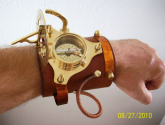You are using an out of date browser. It may not display this or other websites correctly.
You should upgrade or use an alternative browser.
You should upgrade or use an alternative browser.
Facing panels
- Thread starter Battdad89
- Start date
Southeast gets morning sun earlier, but loses afternoon sun earlier... reverse for southwest...
So, full tracking, angle tracking, daylight tracking, or south, in order of maximum output...
So, full tracking, angle tracking, daylight tracking, or south, in order of maximum output...
offgriddle
"FOREVER BEGINNING"
I went out on a mid winters day and faced and angled mine for the noontime sun and that's where I leaveHey! So walking around this morning on the farm as the sun was coming up. Would it make sense to face panels south east and south west like a V almost or plant them in line facing south? I have 1 acre for these so lots of room.
them year round. ?
Obviously tracking a perpendicular angle to the sun is always going to yield the best results but this can be difficult to achieve practically. I would suggest that overall you would not achieve much, if any, additional output positioning your array so and, in addition, you will likely require two SCCs, one for each 'direction', else suffer partial shading dragging your total output down.
offgriddle
"FOREVER BEGINNING"
Once upon a time, a solar guru told me that the energy used in operating a tracking motor required the equivalent energy produced by one solar panel. Do you concur?Obviously tracking a perpendicular angle to the sun is always going to yield the best results but this can be difficult to achieve practically. I would suggest that overall you would not achieve much, if any, additional output positioning your array so and, in addition, you will likely require two SCCs, one for each 'direction', else suffer partial shading dragging your total output down.
I have no practical experience of this but I would find that difficult to believe; I mean stepper motors don't consume inordinate amounts of energy and the associated electronics would be relatively minuscule, and they don't move very much or very quickly. But, honestly, I don't know.
svetz
Works in theory! Practice? That's something else
...Would it make sense to ... [panel configuration ideas]...
SAM is a great tool for playing around with those types of questions and quickly churning out the $ over the life cycle of the panels for your configuration. For example, regarding the Tracker....
Flat, Single, and Dual-Axis
Quick comparison from SAM...
| 7.8kW Array @ Key Largo | Annual kWh predicted for 23 340W LG panels | Equivalent # panels for ~12190 kWh |
| fixed tilt (10°)* | 12,190 | 23 |
| 1 axis tracker (10°) | 14,415 | 20 |
| 2 axis tracker | 17,896 | 16 |
So, for the given location/weather, a dual axis tracker with 5 less panels could provide the same output as a poorly configured array. It won't tell you how much power or maintenance it takes to keep tracker running though.
*Note that 10° is sub-optimal for the latitude but optimal for hurricane force winds (flat to the roof), so the two-axis tracker takes a big jump.
SAM is a great tool for playing around with those types of questions and quickly churning out the $ over the life cycle of the panels for your configuration. For example, regarding the Tracker....
Flat, Single, and Dual-Axis
Quick comparison from SAM...
7.8kW Array @ Key Largo Annual kWh predicted for 23 340W LG panels Equivalent # panels for ~12190 kWh fixed tilt (10°)* 12,190 23 1 axis tracker (10°) 14,415 20 2 axis tracker 17,896 16
So, for the given location/weather, a dual axis tracker with 5 less panels could provide the same output as a poorly configured array. It won't tell you how much power or maintenance it takes to keep tracker running though.
*Note that 10° is sub-optimal for the latitude but optimal for hurricane force winds (flat to the roof), so the two-axis tracker takes a big jump.
This is super cool! Thank you. I will play around with this.
svetz
Works in theory! Practice? That's something else
offgriddle
"FOREVER BEGINNING"
Similar threads
- Replies
- 17
- Views
- 279
- Replies
- 1
- Views
- 269
- Replies
- 66
- Views
- 2K



